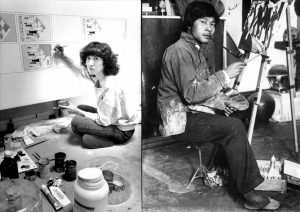
Transnationals in “In Between” Spaces (Introduction)
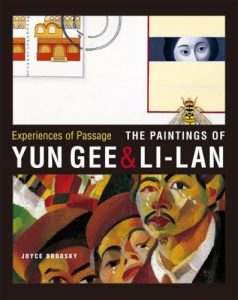
Old certainties – never certainties for everyone in any case – are wearing thin. – Smadar Lavie and Ted Swedenburg
This book is dedicated to the critique of old certainties about culture, place, and nation, in light of transnationalism. As father and daughter. Yun Gee and Li-lan provide the opportunity to study these issues in two very different cultural and historical contexts. While transnationalism is now often identified with globalization, these artists are examples of the desire to live and work free of national restrictions, and openly responsive to diverse cultures, not as a result of art-world trends but because they have embraced these issues in their very lives, and that is embodied in their paintings. Gee was somewhat unusual for his time, not only because he chose to become transnational but also in his desire to explore many cultures and embrace aspects of them in his painting he can be compared to many contemporary artists (I have brought closure to this book in the epilogue by briefly discussing some of them who came originally from China). It is also important to underscore that Gee’s ability to absorb, in a novel manner, aspects of cubism and School of Paris post-World War I painting resulted in important works that should be acknowledged in discussions of the history of modernism. Li-lan, who might be considered transnational in the flesh, as the biracial offspring of a proclaimed world citizen like Gee, was well prepared to explore her historical moment in the world of globalization almost before it produced what is being described as a transnational style. This suggests that having a global sensibility is not directly tied to electronic or economic globalization.
In the cultural production of many biracial and emigrant artists, the notion of hybridity is often introduced in discussions of their work as a way of focusing on the different parts of such artists’ dislocations. With respect to artworks, the term “hybridity” has become a postmodern cliché in the critical practice of deciphering bits and pieces of each national or ethnic part and, at the political or social level, reinforcing “hyphenated subject” positions. In a short essay that Jane C. Ju wrote for a major exhibition of Yun Gee’s paintings at the Taipei Fine Arts Museum in 1992, I was struck by her understanding that hyphenation is often politically loaded, in reaction both to the artist and to the works. Talking about his Paris period, she writes:
From the materials concerning this period of Yun Gee’s life, I found something that puzzled me. Although his paintings were clearly modernistic in expression, i.e., in the mode of Synchromism or Cubism, many writings on his art often describe them as expressing “Chinese” or “Oriental” sensibilities. Since I could not see any “Chineseness” in most of his works (except for those clearly depicting Chinese figures, or those inscribed with Chinese characters), I wondered whether his being a Chinese American had influenced the perception of these writers.
This book explores the lives and works of Yun Gee and Li-lan and is not primarily theoretical, but ideas about hybridity, transnationalism, and cosmopolitanism do inform the work. I call attention briefly to a few of these ideas while remaining aware of the necessity for a fleshed-out study of the relations between theory and practice pertinent to these issues. Such a study would examine, for example, the works of the transnational scholar Homi Bhabha, who is central to this discourse. From within the field of cultural studies, Bhabha has formulated a strong notion of the hybrid as an issue that concerns the individual’s response from the inside to the various outsides, as opposed to the hybridity that exploits the fragmentation stemming from dislocation. Lavie and Swedenburg agree with Bhabha that in the realm of the political the notion of the hybrid is crucial in the sense that “all cultures turn out to be, in various ways, hybrid. Intercultural creations and miscegenations expose as a hoax the modernist and colonialist discourse concerning homogeneity of cultures-a myth sustained chiefly by the center’s stranglehold on the global economy.”
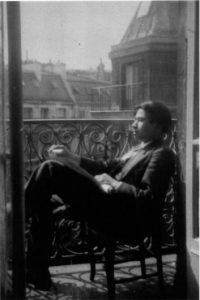
Yun Gee – Paris
Hybridity, then, turns out to be a very complex notion, with many critical issues emerging from the growing literature that explores the ramifications of mixed cultures and ethnicities. In relation to the task at hand-tthe study of transnational artists- two problems emerge as particularly consequential. In a broad social, political, and cultural sense, the superficial recognition of hyphenation and hybridity as difference not only may perpetuate a subtle level of discrimination but also may result in deflection from the necessary commitment to change that actually supports diversity. Moreover, transnationalism can aspire to a simpleminded desire for universality or transcendence that results in blindness to local differences and conditions and can sometimes support a dangerous return to essentialist notions. At a more personal level, in the lives of the artists I am discussing, these overriding concerns play out in the daily negotiation between the acceptance of their hybrid nature, even in the face of hostility, and the desire for a harmony that is inclusive of that diversity. What may emerge from the struggle is constitutive of the stronger notion of the hybrid embedded in a different kind of vision that forges coherence from the cultural parts. This may materialize from what Homi Bhabha labels being in “the third, or in-between, or transnational space.” It is this more profound notion that is decisive in understanding the life and works of Yun Gee and Li-lan.
Bhabha also writes that critique itself is effective because it “opens up a space of translation,” a “place of hybridity,” which allows for the creation of something new that is “neither the one nor the other.” Bhabha’s essay is dedicated to the creative and political role of theory as such in its interaction with practice, but it can be applied to the life and work of artists like Yun Gee and Li-lan, who reside in their respective transnational spaces. While seemingly fraught with the anxieties of exile that Edward M. Said so poignantly describes as “the unhealable rift forced between a human being and a native place, between the self and its true home,” such that “its essential sadness can never be surmounted,” it is none the less true that “both the new and the old environments are vivid, actual, occurring together contrapuntally.” That sadness may characterize the past and present exilic situations of the many, but in the hope for a future in a post-national world such passages may be less burdensome. In the meantime, the contrapuntal may be the rub that stimulates new kinds of perceptions embodied in original works. I think that critical energy is what characterizes the work of many transnational artists like Yun Gee and Li-lan.
Now that almost every place in the world is inhabited by immigrants or biracial persons, what does it particularly mean to be a cosmopolite or a transnational? I use those designations for persons who embrace their multinational, multicultural, and multiracial experiences and, as a result, combine them intrinsically, sometimes in spite of the pain that this complex passage may entail. This approach often contrasts with that of those who migrate but who choose, for all sorts of complex reasons, to remain rooted in the structures of their social, cultural, racial, or ethnic origins. People in the former group, just because of their desire to be inclusive, often gain a special awareness of others and an acceptance of diversity in the life lived and the work produced. Irit Rogoff has lived the life of a transnational, and she explores the ramifications in an excellent study where she writes about herself:
It seems important to say in this context that I am currently on my fourth country and third language; none of my displacement has been the least tragic, like the plight of those forced to leave homelands for political and intellectual reasons. My movement has had to do with a restless curiosity, opportunities, and the making of certain choices, not much more…. Nevertheless, my own displacement entails complex daily negotiations between all the cultures and languages and histories which inhabit me, resulting in the suspension of belief in the possibility of either coherent narratives or sign systems that can actually reflect straight forward relations between subjects, places, and identities.
These ruminations are particularly apt for discussions about the lives of Yun Gee and Li-lan. If I qualify Rogoff’s comments in any way, it is to suggest that for these two artists there is a kind of coherence that emerges from the “complex daily negotiations between all the cultures and languages and histories” that inhabit them. I hope to show that there is a wholeness to their lives and to their work that ought to be the focus of inquiry, replacing the emphasis on their being Chinese Americans. While the term “Chinese American” is descriptive in different ways of both Gee and Li-lan, as such terms are for many “hyphenated” persons, racial implications may be at play.
In the case of Yun Gee, how does the artist’s being a transnational cause his situation to differ, in terms of creative production, from the situation of any other émigré artist in any time frame? If I considered only the twentieth century and restricted my question, for the moment, to Europeans who emigrated to the United States, I would be considering hundreds of artists who escaped poverty and persecution, the latter predominantly occasioned by Fascism. They took with them the social and cultural experiences of their home countries, as did Gee. I think the difference lies both in the forced nature of their exodus and in the artistic ambiences of their native countries. For the most part, European artists brought the avant-garde modernist experiences of the late nineteenth and early twentieth centuries here and continued to explore them. They were already formed as artists and, at first, were not particularly interested in the art of their adopted country. While some of them did engage aspects of American culture, for the most part they provided the new creative direction that would change the art of the United States; Willem de Kooning is a prime example of such an artist. Most Asian émigré artists were trained in what were considered to be the more traditional styles of the countries from which they came, or in a form of Western art deemed provincial and academic in the West. Even if, as may have been the case for Gee, they were aware of some of the latest forms of Western art, they had to learn to create works in the adopted country’s idioms of the time if they wanted to compete on the national scene.
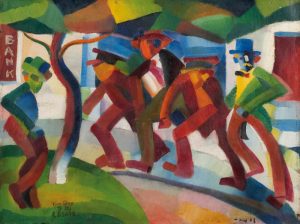
Yun Gee Grand voleur et petit voleur – 1927
While Gee had a more difficult time living and working in the first half of the twentieth century, and particularly during the war years, he had much in common with many contemporary transnational artists who are not driven from their native countries because of obvious repression or poverty but often move around in order to engage other contemporary ideas and audiences. As Gee did, many of them live for periods of time in several art centers and are conversant with the “international” styles practiced there. They seek out these spaces and often produce work that embodies their complex cultural experiences. Yun Gee may seem to differ from them somewhat because international institutions like biennales did not exist in the early twentieth century, nor did such media of mass communication as the World Wide Web, and traveling to faraway places was still difficult; moreover, Gee was poor. He also faced a form of racism that is less overt today for artists who move to major cosmopolitan centers. As a creative intellectual, however, he adopted Western modernism very quickly, just as his contemporary counterparts embrace global art forms. Although he found his stylistic vocabulary first in the United States and later in Paris, from his early years he had effortlessly been absorbing other social and cultural milieus. Gee was fully engaged with the social, political, and artistic environments in which he lived at any given time. He probably learned about the art and culture of other countries, perhaps Japan and France, through his education in China because he spent his childhood during a revolution that introduced many Western ideas, often by way of Japanese examples. He painted some important works with Chinese themes, but particularly when he went to Paris, and later in New York, such themes became infrequent in his work, as did Christian themes. His work was primarily secular in content-genre scenes, cityscapes, portraits-and he shares with many recent transnational émigrés a unity of vision that in his best paintings is more than just a blending or synthesis of different cultures. As Gee wrote in a short article,
When I visited the Louvre day after day, the Masterpieces there spoke to me in a language which was neither French nor Chinese but which transcended time and place. Here was something universal which had meaning for every man regardless of race or state. A painting by Cézanne or Courbet became as close to me as any of the scrolls by the Chinese masters with which I was so familiar. And I realized that East and West were not so far apart, for in their finest creative effort, there was something very much akin.
The chapters in this book about Gee’s life and work examine the particular factors that enabled this person from a provincial village in southern China to live and work in what we now label a transnational mode.
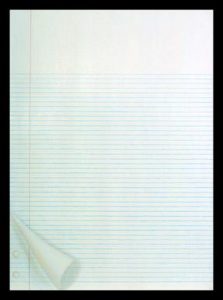
Li-lan Forgotten Memo – 1976
The situation of Li-lan is obviously another matter. She is the daughter of parents who both participated in the cultural world of New York City, and her experiences growing up biracial in the second half of the twentieth century constitute a different kind of passage from Yun Gee’s. She is an American of mixed parentage, as are growing numbers of people born in the United States, but in spite of their numbers, isolation plays a part in many of their stories. In her early years, Li-lan felt cut off from her peers, partially as a result of being perceived as “an Oriental,” and she felt abandoned because she did not receive the emotional support she needed from her mother, with whom she had a more than complicated relationship. Li-lan functions in a manner different from that of her father, but still in the kind of “in between” space that can also be related to transnationalism. While living with her mother, Li-lan writes, “I visited my father in his top-floor walk-up from the time my parents separated, and subsequently divorced, when I was two, until he died, when I was twenty. During those years, my father’s paintings inhabited my visual world.” Her artistic foundation was her early experience in her father’s studio, where she absorbed elements of Chinese art and culture alongside his “Western”-style painting and his knowledge about Western philosophy and literature and, later on, international surrealism and New York’s pop art and minimalism. She acquired firsthand knowledge of Japanese art when she married the printmaker Masuo Ikeda and lived in Japan for many years. More recent encounters are subtly changing her work as she exhibits in Taiwan (and now in China) and travels in China, and to the village where her father was born. She is at ease in Eastern as well as Western environments, and although she produces work with a different form of unity from that which characterizes Yun Gee’s painting, she also circumvents the fragmentation that is so characteristic of facile hybrid practices.
As previously indicated, discussions of hybridity and transnationalism are fraught with pitfalls. While I am claiming for Yun Gee and Li-lan a different kind of vision, one that seems to bypass acknowledgment of the various components of their cultural heritages in a mode I call “transnational,” it is none the less obvious that the elements forming that complexity can be identified. I have discussed aspects of both artists’ lives and works that point to influences that can be characterized as Eastern or Western. What I am suggesting, however, is that it is the desire to create a different kind of unity that is most compelling in both of their endeavors, and that emerges from and in spite of the difficulties of the experiences of passage. Discussions about what is constitutive of this new approach are only now taking place, and my contribution to the dialogue is in the formative stage. First it is necessary to study in depth how Yun Gee and Li-lan have created images of negotiation between both the hybrid and the transnational aspects of their lives, and that is what this book is about.
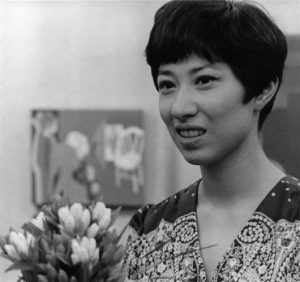
Li-lan – Tokyo 1969
Underlying these issues-in this case, issues about being Asian-are the problems associated with the “marked body” as the site of both stereotype and critique. I will refer to particular instances of these issues in discussing both artists’ lives. It is interesting, however, that Yun Gee’s habit of always wearing Western dress except in music and dance performances, and his desire to look like an artist and a bohemian in San Francisco and New York, were adornments of the body that he adopted not to disguise his being Chinese-which would have been impossible anyway, given his features-but to declare his modernity and his freedom from the stereotypical Chinese body. Li-lan grew up biracial, and Western dress was normal attire for her. What is fascinating in her case is her withdrawal from her Chinese body when she was young, so much so that she detested the Chinese costumes her mother had her wear on certain occasions. Recently some of her paintings include Asian eyes, and her attire is styled in part by Asian designers; she also sometimes wore Kimonos while living in Japan. Factors in life and work for both father and daughter are suffering through racist stereotyping and willingness to use the body freely so as to assert mastery.
In this connection, I am reminded of the marvelous image of the fragile Maya Lin before a committee of congressmen and military veterans. She was being ruthlessly impugned over her design for the Vietnam memorial, partly because she is Asian. She wore a flowing dress and a huge hat that called attention to her difference from all the others, who were wearing suits or uniforms. She spoke softly, but some of her power resided in her daring to parade a highly feminine costume in that setting rather than one that would have blended in with the mostly male bodies surrounding her. She was in control of “othering” all the others. Biracial artists like Maya Lin and Li-lan and transnational artists like Yun Gee may be burdened by the effects of racism and bigotry, but the perceptions they gain from their location in the “third space” may provide them with insights that strengthen their resolve and enrich their art practice. I hope to show that this is true for both Yun Gee and his daughter, Li-lan.
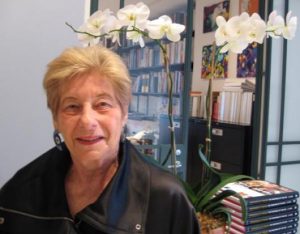
Joyce Brodskyis professor emeritus of art and theory at the University of California, Santa Cruz. She is the author of the first major exhibition catalogue of Yun Gee’s paintings.
Experiences of Passage: The Paintings of Yun Gee and Li-lan is now available:
Barnes & Noble
Amazon
University of Washington Press
•BACK•